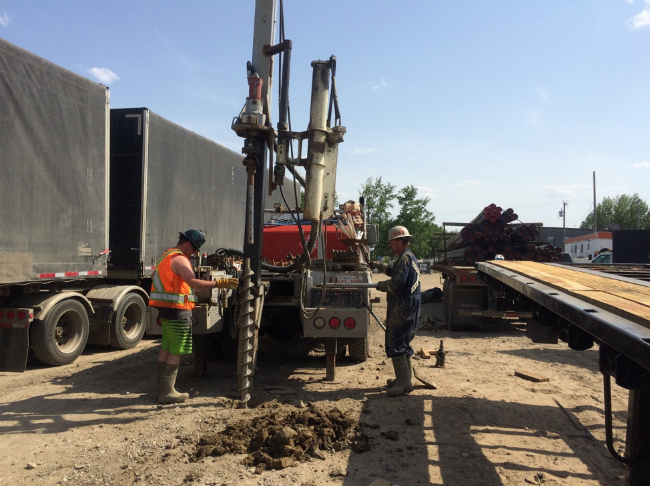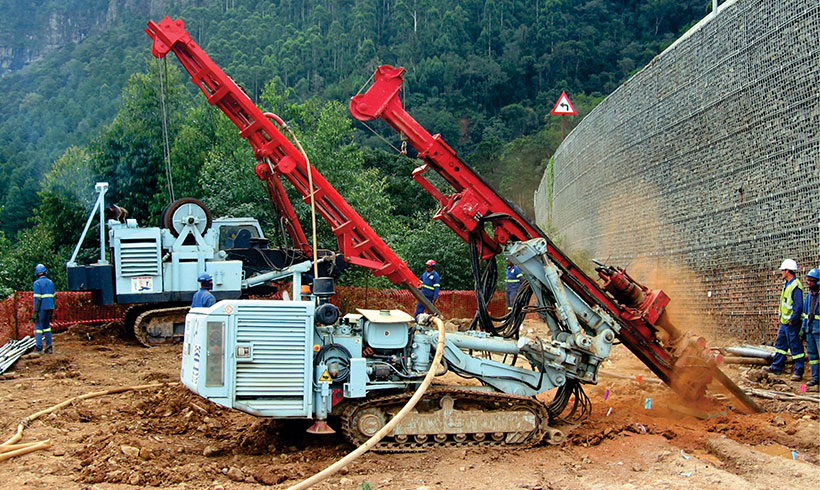Discovering the Basic Concepts and Applications of Geotechnical Design for Sustainable Infrastructure Growth
The crossway of geotechnical engineering and lasting facilities development offers an engaging possibility to improve both style efficacy and ecological responsibility. By comprehending essential principles such as soil technicians, website characterization, and foundation design techniques, designers can develop remedies that are not just efficient yet additionally decrease ecological footprints.
Secret Principles of Geotechnical Engineering
Understanding the essential concepts of geotechnical design is crucial for creating lasting facilities (about geotechnical engineering). This discipline concentrates on the communication in between dirt, rock, and frameworks, playing an important role in the stability and efficiency of engineering projects. The leading principle is the evaluation of subsurface conditions through website examinations, which provide useful information about dirt residential or commercial properties, stratification, and groundwater degrees
An additional essential concept is the application of effective tension concept, which helps designers understand just how soil actions changes under varying tons. This understanding is important for assessing the bearing ability of structures and guaranteeing that frameworks can hold up against both dynamic and fixed forces.
In addition, the principles of soil-structure interaction and slope security are indispensable to geotechnical style, as they educate decisions on the placement and style of keeping wall surfaces, embankments, and inclines.
Last but not least, geotechnical engineers should consider sustainability by promoting making use of in your area sourced materials, minimizing environmental effect, and enhancing layouts for long life. By sticking to these principles, geotechnical engineering adds significantly to the development of resistant and sustainable facilities that satisfies the demands of culture while shielding the environment.
Dirt Mechanics and Its Importance
Soil technicians works as the foundation of geotechnical engineering, providing the scientific concepts needed to examine the behavior of dirt under various conditions. Comprehending soil technicians is critical for anticipating how soil will certainly react to loads, adjustments in moisture material, and other environmental elements. This knowledge enables engineers to make structures that can hold up against the pressures put in by the soil and make sure stability and safety and security.
The study of dirt technicians includes various aspects, including soil classification, shear compressibility, leaks in the structure, and stamina. These aspects affect the style of structures, keeping wall surfaces, and other geotechnical frameworks, making it crucial to assess soil residential properties accurately. The shear stamina of dirt straight impacts the stability of excavations and inclines, while compressibility affects settlement predictions for structures.
Additionally, soil auto mechanics plays an important duty in lasting framework development. By understanding the soil's actions, engineers can minimize ecological impacts, optimize material use, and enhance the durability of frameworks. This integration of soil mechanics right into geotechnical design methods not just makes certain safety and security however also adds to the general sustainability of construction projects, promoting reliable resource administration and ecological stewardship.
Website Characterization Techniques
Effective website characterization techniques are critical for collecting important information regarding subsurface conditions before building and construction - geotechnical engineer description. These techniques give useful understandings right into dirt properties, rock developments, groundwater levels, and check that prospective geohazards, therefore informing project style and mitigating dangers
One widely utilized approach is piercing, which permits direct tasting of soil and rock layers. This can be matched by in-situ testing, such as Basic Penetration Tests (SPT) and Cone Penetration Tests (CPT), to evaluate soil stamina and stratification. Geophysical approaches, including seismic refraction and electrical resistivity studies, enable non-invasive analysis of subsurface materials and structures, offering a wider perspective on geological problems.
Furthermore, research laboratory screening plays an essential role in evaluating soil samples acquired from boring. Tests such as grain dimension analysis, Atterberg limitations, and triaxial shear tests yield critical information on soil habits under different loading problems.
Integrating these website characterization methods not only boosts the understanding of website conditions yet also supports lasting framework advancement by guaranteeing that tasks are made with proper safety and security margins and performance specifications. Therefore, a thorough site characterization is crucial for notified decision-making in geotechnical engineering.
Structure Layout Methods
Structure layout techniques are crucial for guaranteeing the stability and longevity of structures in different geotechnical contexts. These strategies start with an extensive site examination, that includes soil testing and evaluation to establish the physical buildings of the subsoil. Understanding soil actions under lots is important for selecting the ideal foundation type, whether shallow or deep.
Shallow foundations, such as spread grounds or floor covering foundations, are generally employed when appropriate soil layers are offered near the surface area. Alternatively, deep foundations, such as stacks or drilled shafts, are made use of in circumstances where surface area soils are poor to sustain structural tons.

Lasting Practices in Geotechnical Design
The combination of lasting techniques in geotechnical design plays a critical function in improving the environmental and economic feasibility of framework tasks. By prioritizing source performance and lessening ecological impacts, designers can add to the development of resistant infrastructure systems.
One trick lasting method involves using alternate products, such as recycled aggregates and commercial byproducts, which can reduce the need for virgin sources and lower carbon discharges. Additionally, soil stabilization strategies, consisting of the application of bioengineering approaches, improve dirt residential or commercial properties while promoting ecological equilibrium.
In addition, the implementation of advanced geotechnical modeling and tracking innovations permits far better prediction and management of ground problems, causing enhanced design services and resource application. These innovations also facilitate the evaluation of long-lasting efficiency, guaranteeing that structures stay secure and practical over their life-span.

Conclusion
Finally, the concepts and applications of geotechnical engineering play a crucial function in sustainable infrastructure development. Highlighting dirt mechanics, website characterization, and cutting-edge foundation layout approaches enhances the resilience and efficiency of structures. The assimilation of sustainable techniques, consisting of using locally sourced products and progressed stabilization strategies, not just maximizes resource utilization however additionally advertises ecological stewardship. Ultimately, these initiatives add to the creation of facilities that properly meets social requirements while decreasing environmental impact.
By recognizing vital principles such as soil mechanics, website characterization, and foundation layout techniques, engineers can create remedies that are not just reliable however additionally decrease ecological impacts.Dirt technicians offers as the structure of geotechnical engineering, offering the clinical principles required to analyze the behavior of soil under different problems. Comprehending soil technicians is vital for predicting just how dirt will respond to loads, adjustments in dampness content, and other environmental elements.The research study of soil mechanics includes various elements, including dirt classification, shear compressibility, strength, and permeability. These variables influence the layout of foundations, keeping wall surfaces, and various other geotechnical visite site structures, making it necessary to analyze soil residential properties precisely.